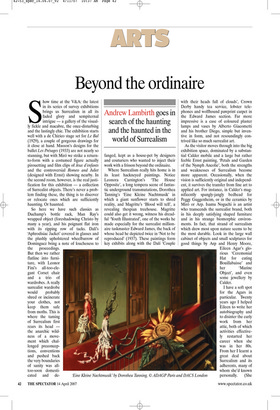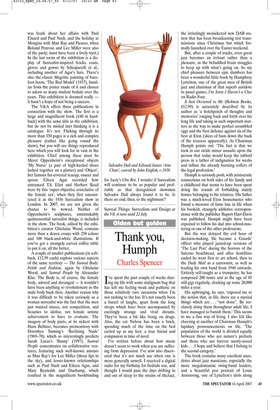Beyond the ordinaire
Andrew Lambirth goes in search of the haunting and the haunted in the world of Surrealism
Show time at the V&A: the latest in its series of survey exhibitions brings us Surrealism in all its faded glory and sempiternal intrigue — a gallery of the visually fickle and macabre, the once-disturbing and the lastingly chic. The exhibition starts well with a de Chirico stage set for Le Bal (1929), a couple of gorgeous drawings for it close at hand. Masson’s designs for the ballet Les Présages (1933) are not nearly so stunning, but with Miró we strike a returnto-form with a costumed figure actually pirouetting and film clips of Jeux d’enfants and the controversial Romeo and Juliet (designed with Ernst) showing nearby. In the second room, however, is the real justification for this exhibition — a collection of Surrealist objects. There’s never a problem finding these, the thing is to discover or relocate ones which are sufficiently haunting. Or haunted. fanged, kept as a house-pet by designers and couturiers who wanted to inject their work with a frisson beyond the ordinaire.
Where Surrealism really hits home is in its least hackneyed paintings. Notice Leonora Carrington’s ‘The House Opposite’, a long tempera scene of fantastic underground transmutations, Dorothea Tanning’s ‘Eine Kleine Nachtmusik’ in which a giant sunflower starts to shred reality, and Magritte’s ‘Blood will tell’, a revealing thespian treehouse. Magritte could also get it wrong, witness his dreadful ‘Youth Illustrated’, one of the works he made especially for the surrealist millionaire taskmaster Edward James, the back of whose head he depicted twice in ‘Not to be reproduced’ (1937). These paintings form key exhibits along with the Dalí ‘Couple with their heads full of clouds’, Crown Derby handy tea service, lobster telephones and wolfhound pawprint carpet in the Edward James section. Far more impressive is a case of coloured plaster lamps and vases by Alberto Giacometti and his brother Diego, simple but inventive in form, and not resoundingly contrived like so much surrealist art.
As the visitor moves through into the big exhibition space, dominated by a substantial Calder mobile and a large but rather feeble Ernst painting, ‘Petals and Garden of the Nymph Ancolie’, both the strengths and weaknesses of Surrealism become more apparent. Occasionally, when the vision is sufficiently original and independent, it survives the transfer from fine art to applied art. For instance, in Calder’s magnificently spangly-jangly bedhead for Peggy Guggenheim, or in the ceramics by Miró or Arp. Isamu Noguchi is an artist who transcends the surrealist brand, both in his deeply satisfying shaped furniture and in his strange biomorphic environments. In fact, that strand of surrealism which drew most upon nature seems to be the most durable. Look in the large wall cabinet of objects and small sculptures for good things by Arp and Henry Moore, Eileen Agar’s glorious ‘Ceremonial Hat for eating Bouillabaisse’ and her ‘Marine Object’, and even some jewellery by Calder.
I have a soft spot for the Agars in particular. Twenty years ago I helped Eileen to write her autobiography and to disinter the early work from her attic, both of which activities effectively restarted her career when she was in her 80s. From her I learnt a great deal about Surrealism and its adherents, many of whom she’d known personally. (She was frank about her affairs with Paul Eluard and Paul Nash, and the holiday at Mougins with Man Ray and Picasso, when Roland Penrose and Lee Miller were also of the party; must have been a lively tryst.) In the last room of the exhibition is a display of Surrealist-inspired frocks, coats, gloves and gowns by Schiaparelli et al., including another of Agar’s hats. There’s also the classic Magritte painting of barefoot boots, ‘The Red Model’ (1937), familiar from the poster made of it and chosen to adorn so many student bedsits over the years. This exhibition is doomed really it hasn’t a hope of not being a success.
The V&A offers three publications in connection with the show. The first is a large and magnificent book (£40 in hardback) with the same title as the exhibition, but do not be misled into thinking it is a catalogue. It’s not. Flicking through its more than 350 pages is a rich and complex pleasure (rather like going round the show), but you will see things reproduced here which you will look for in vain in the exhibition. Chief among these must be Meret Oppenheim’s exceptional objects ‘My Nurse’ (a pair of high-heeled shoes lashed together on a platter) and ‘Object’, her famous fur-covered teacup, saucer and spoon. Eileen Agar recorded how entranced T.S. Eliot and Herbert Read were by this ‘super-objective correlative of the female sex’, when they first encountered it at the 1936 Surrealism show in London. In 2007, we are not given the chance to be wowed. Neither of Oppenheim’s sculptures, unmistakably quintessential surrealist things, is included in the show. The book, edited by the exhibition’s curator Ghislaine Wood, contains more than a dozen essays with 250 colour and 100 black-and-white illustrations. If you’ve got a strangely carved coffee table to put it on, all the better.
A couple of smaller publications (in softback, £12.99 each) explore various aspects of the same territory — The Surreal Body: Fetish and Fashion, again by Ghislaine Wood, and Surreal People by Alexander Klar. The Body is, of course, the female body, adored and deranged — it wouldn’t have been anything so revolutionary as the male body back then. Another reason why it was difficult to be taken seriously as a woman surrealist was the fact that the men just wanted muses, not competition, and beauties to idolise, not female artistic achievement to have to evaluate. The imagery of body parts, at its sickest with Hans Bellmer, becomes premonitory with Dorothea Tanning’s ‘Reclining Nude’ (1969–70), which so interestingly predicts Sarah Lucas’s ‘Bunny’ (1997). Surreal People concentrates on collaborative ventures, featuring such well-known amours as Man Ray’s for Lee Miller (those lips in the sky), and lesser-known relationships such as Paul Nash and Eileen Agar, and Mary Reynolds and Duchamp, which resulted in the magnificent bookbinding for Jarry’s Ubu Roi. I wonder if Surrealism will continue to be as popular and profitable as that deregulated showman Salvador Dalí always found it to be. Is there no end, then, to the nightmare?



































































 Previous page
Previous page